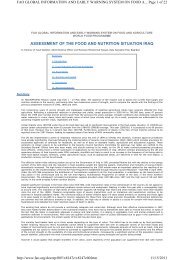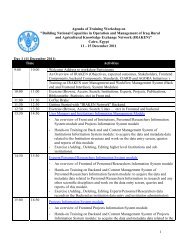Vermiculture in Egypt: - FAO - Regional Office for the Near East and
Vermiculture in Egypt: - FAO - Regional Office for the Near East and
Vermiculture in Egypt: - FAO - Regional Office for the Near East and
You also want an ePaper? Increase the reach of your titles
YUMPU automatically turns print PDFs into web optimized ePapers that Google loves.
7. Current on-farm <strong>and</strong> urban organic waste management practices<br />
<strong>and</strong> environmental effects of those practices, e.g. carbon <strong>and</strong> methane<br />
emissions.<br />
The ma<strong>in</strong> beneficiaries of this work are <strong>the</strong> agriculture producers <strong>in</strong> general <strong>and</strong><br />
organic farm<strong>in</strong>g producers specifically. Previous chapters covered all aspects of<br />
production of vermicompost <strong>and</strong> vermiculture. As an organic grower <strong>in</strong>terest, <strong>the</strong><br />
environmental positive impacts of utiliz<strong>in</strong>g such methods of production, it is<br />
important to underst<strong>and</strong> how vermicompost contribute to improve reduc<strong>in</strong>g <strong>the</strong><br />
production of greenhouse gases, <strong>and</strong> consequently help mitigat<strong>in</strong>g <strong>the</strong> global<br />
warm<strong>in</strong>g. This chapter aims at highlight<strong>in</strong>g on-farm <strong>and</strong> urban organic waste<br />
management practices <strong>and</strong> <strong>the</strong> environmental effects of those practices.<br />
7.1. Emissions from vermicompost<br />
Compost<strong>in</strong>g has been identified as an important source of CH4 <strong>and</strong> N2O. With<br />
<strong>in</strong>creas<strong>in</strong>g divergence of biodegradable waste from l<strong>and</strong>fill <strong>in</strong>to <strong>the</strong> compost<strong>in</strong>g<br />
sector, it is important to quantify emissions of CH4 <strong>and</strong> N2O from all <strong>for</strong>ms of<br />
compost<strong>in</strong>g <strong>and</strong> from all stages. The study focused on <strong>the</strong> f<strong>in</strong>al phase of a two stage<br />
compost<strong>in</strong>g process <strong>and</strong> compared <strong>the</strong> generation <strong>and</strong> emission of CH4 <strong>and</strong> N2O<br />
associated with two differ<strong>in</strong>g compost<strong>in</strong>g methods: mechanically turned w<strong>in</strong>drow <strong>and</strong><br />
vermicompost<strong>in</strong>g. The mechanically turned w<strong>in</strong>drow system was characterized by<br />
emissions of CH4 <strong>and</strong> to a much lesser extent N2O. However, <strong>the</strong> vermicompost<strong>in</strong>g<br />
system emitted significant fluxes of N2O <strong>and</strong> only traces amounts of CH4. High N2O<br />
emission rates from vermicompost<strong>in</strong>g were ascribed to strongly nitrify<strong>in</strong>g conditions<br />
<strong>in</strong> <strong>the</strong> process<strong>in</strong>g beds comb<strong>in</strong>ed with <strong>the</strong> presence of de-nitrify<strong>in</strong>g bacteria with<strong>in</strong> <strong>the</strong><br />
worm gut (Hobson et al., 2005).<br />
Different o<strong>the</strong>r reports from several countries stated that any possible emissions of<br />
greenhouse gases by earthworms from soil or vermicompost<strong>in</strong>g systems is extremely<br />
small when compared with <strong>the</strong> well-documented emissions of nitrous oxide, methane<br />
<strong>and</strong> carbon dioxide from <strong>in</strong>organic fertilizer manufacture, l<strong>and</strong>fills, manure heaps,<br />
lagoons, crop residues <strong>in</strong> soils <strong>and</strong> manure from pigs <strong>and</strong> cattle <strong>in</strong> housed systems.<br />
While <strong>the</strong>re will be N2O emissions from all <strong>the</strong>se sources, <strong>the</strong>re is no justification <strong>for</strong><br />
suggest<strong>in</strong>g that environmentally-friendly <strong>and</strong> energy-efficient systems <strong>for</strong> produc<strong>in</strong>g<br />
vermicomposts <strong>and</strong> composts should be restricted because of <strong>the</strong>ir potential to<br />
produce greenhouse gases. The global production of nitrogenous greenhouse gases <strong>in</strong><br />
agriculture should be compared from all sources be<strong>for</strong>e vermicompost<strong>in</strong>g is publicly<br />
condemned <strong>in</strong> such a sensational way (Edwards, 2008).<br />
Recent research has shown that certa<strong>in</strong> types of vermicompost<strong>in</strong>g can generate<br />
significant amounts of N2O. These <strong>in</strong>itial f<strong>in</strong>d<strong>in</strong>gs <strong>in</strong>dicate a need <strong>for</strong> more research to<br />
be conducted be<strong>for</strong>e any sound recommendations on vermicompost<strong>in</strong>g can be given.<br />
S<strong>in</strong>ce <strong>the</strong> amount of emissions from compost<strong>in</strong>g depends on <strong>the</strong> specific compost<strong>in</strong>g<br />
method used <strong>and</strong> on how well <strong>the</strong> process is managed, it is not possible to give a<br />
62





